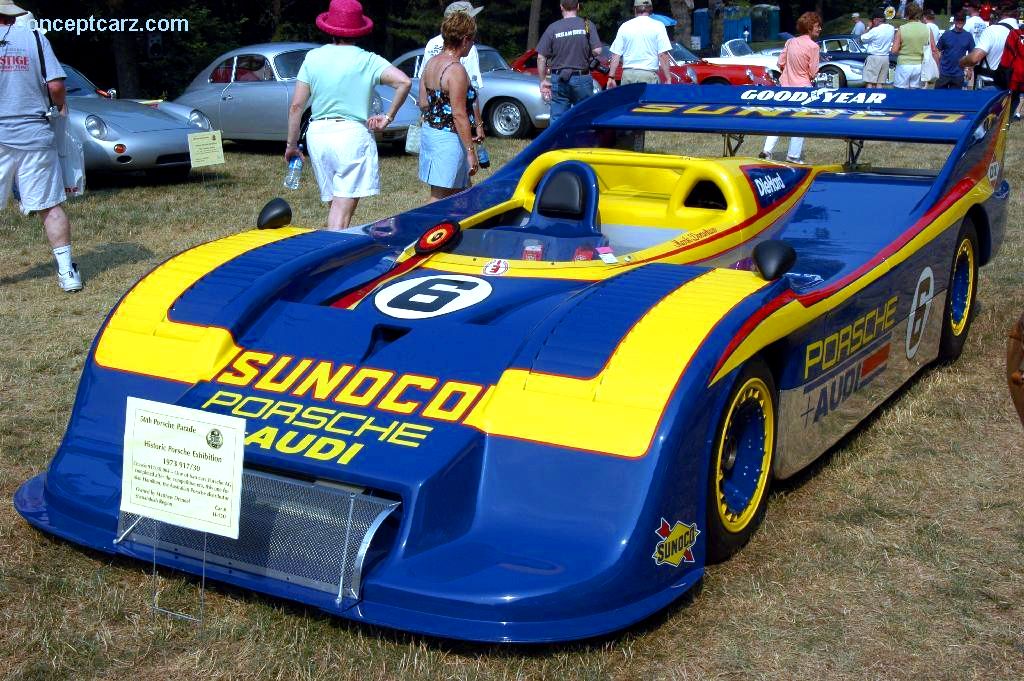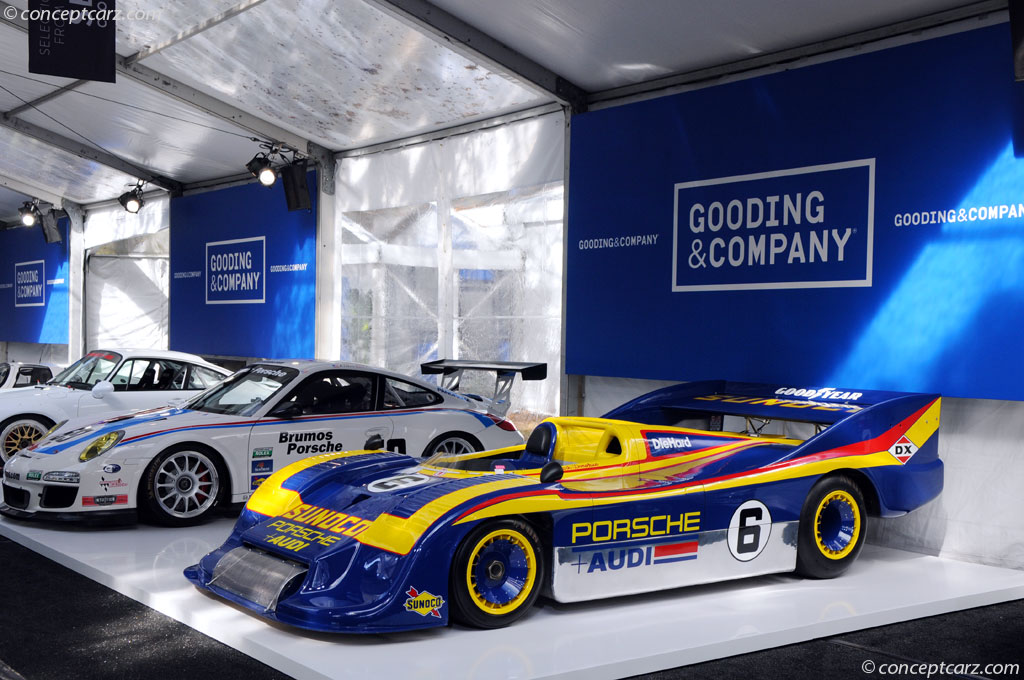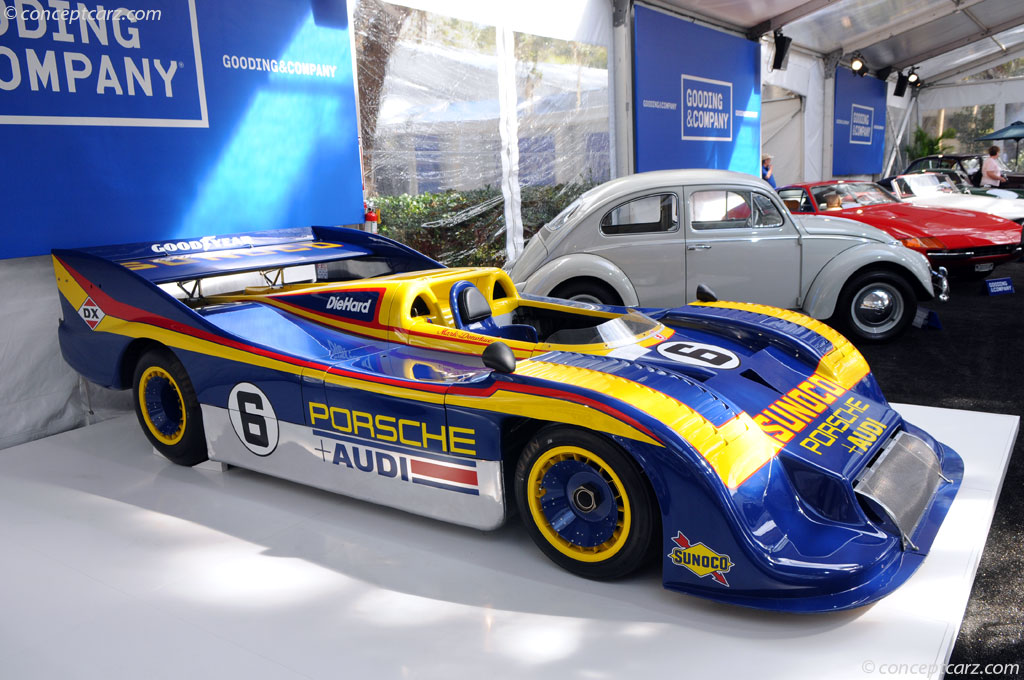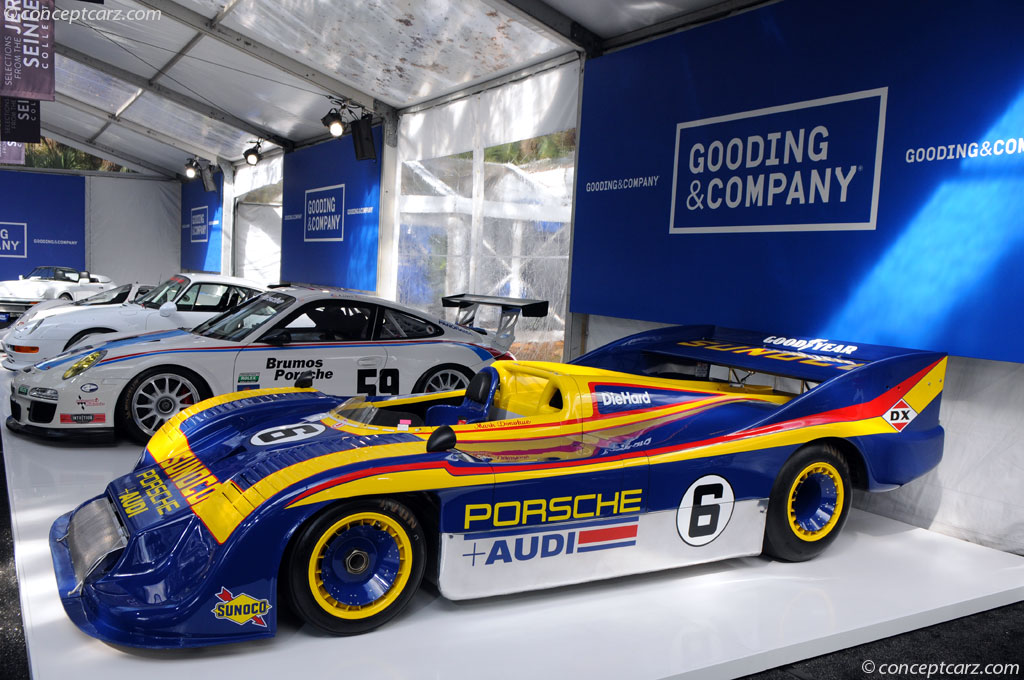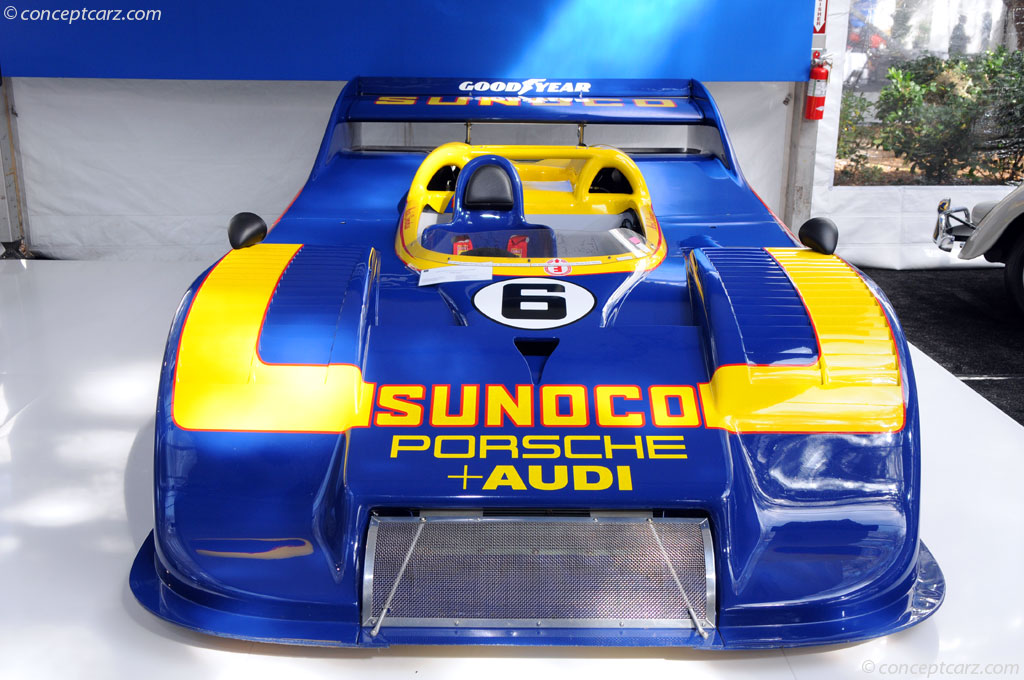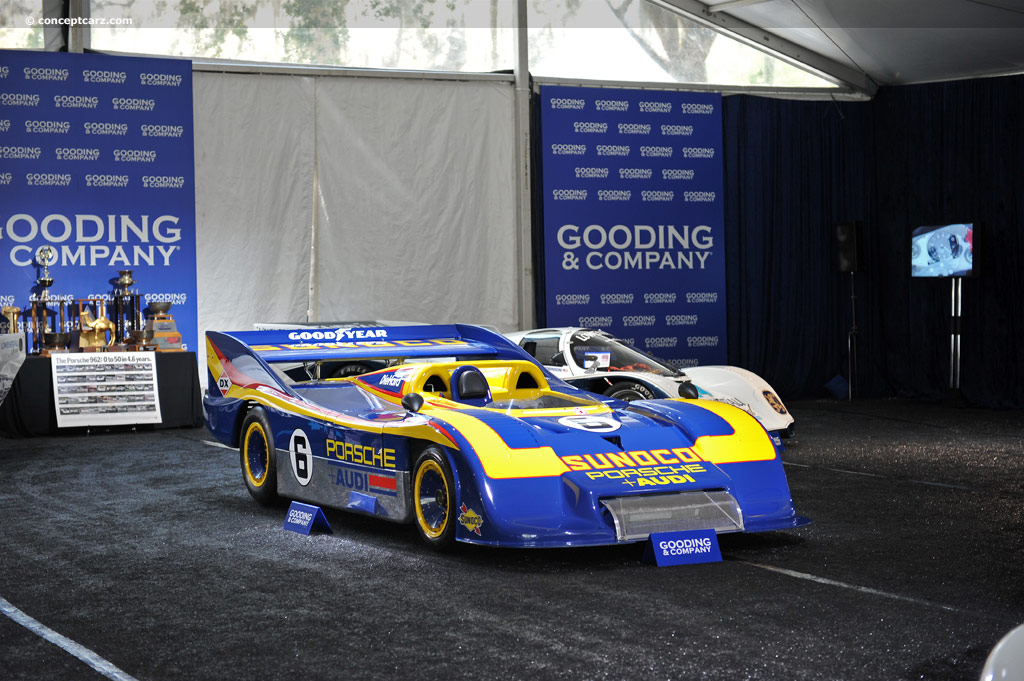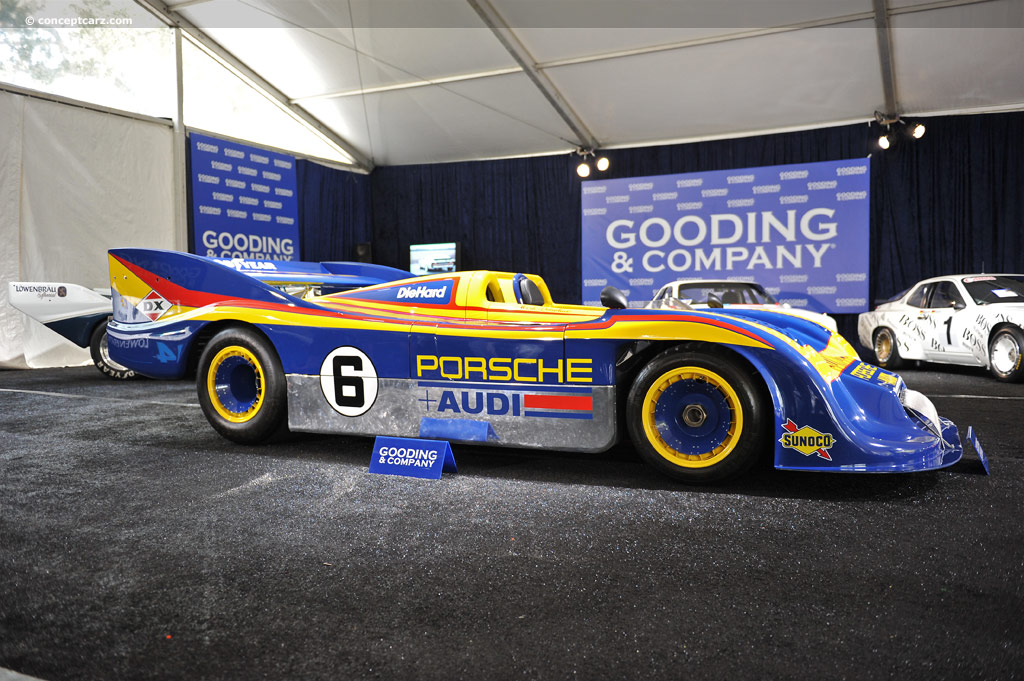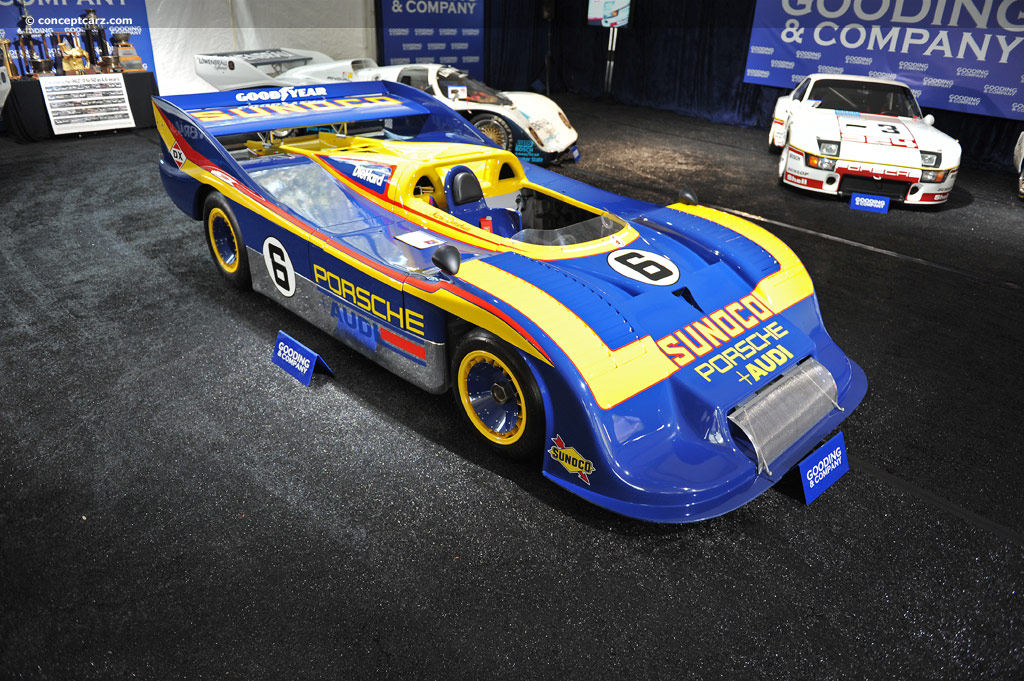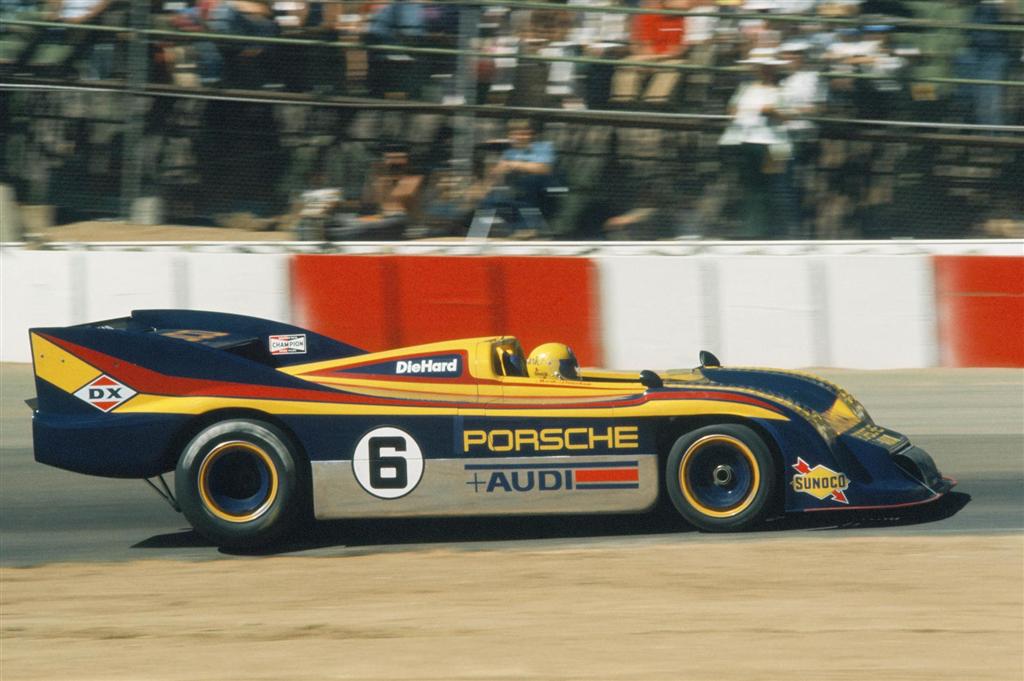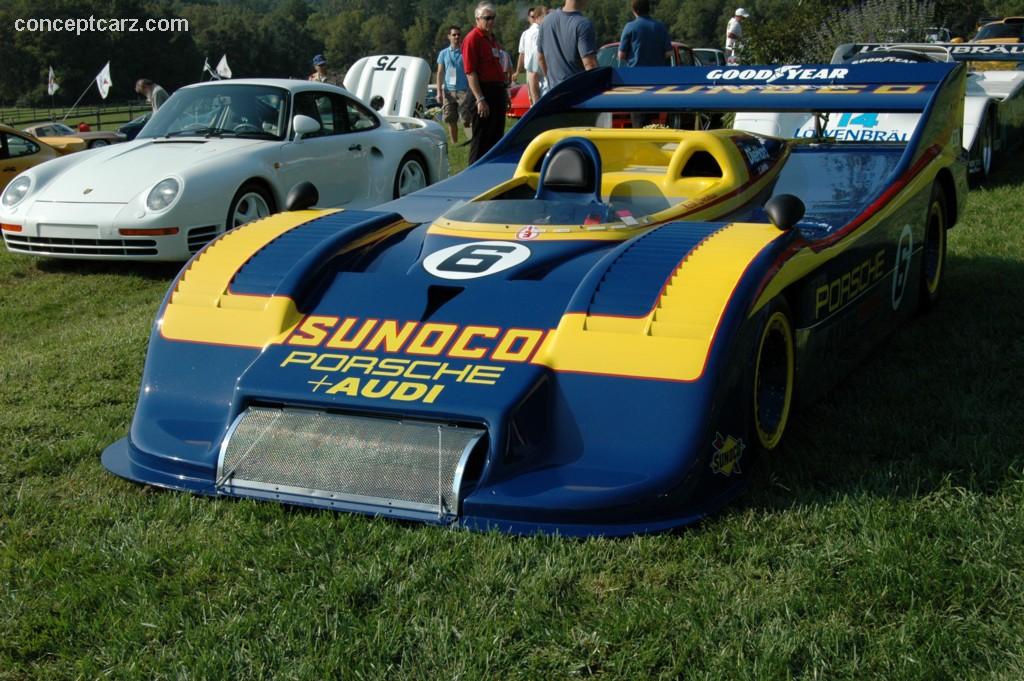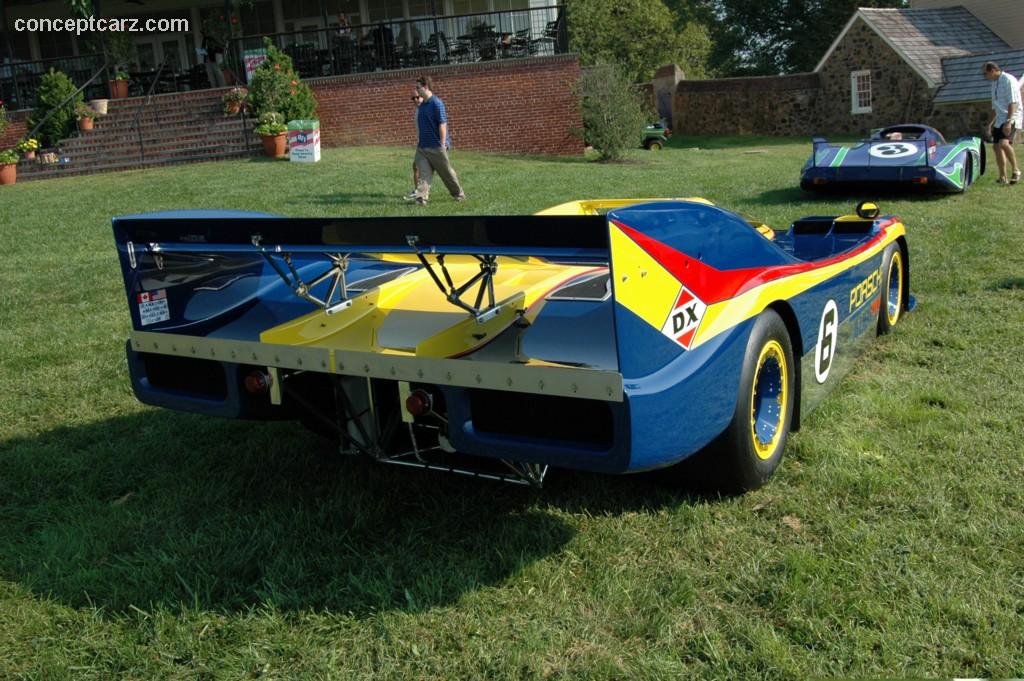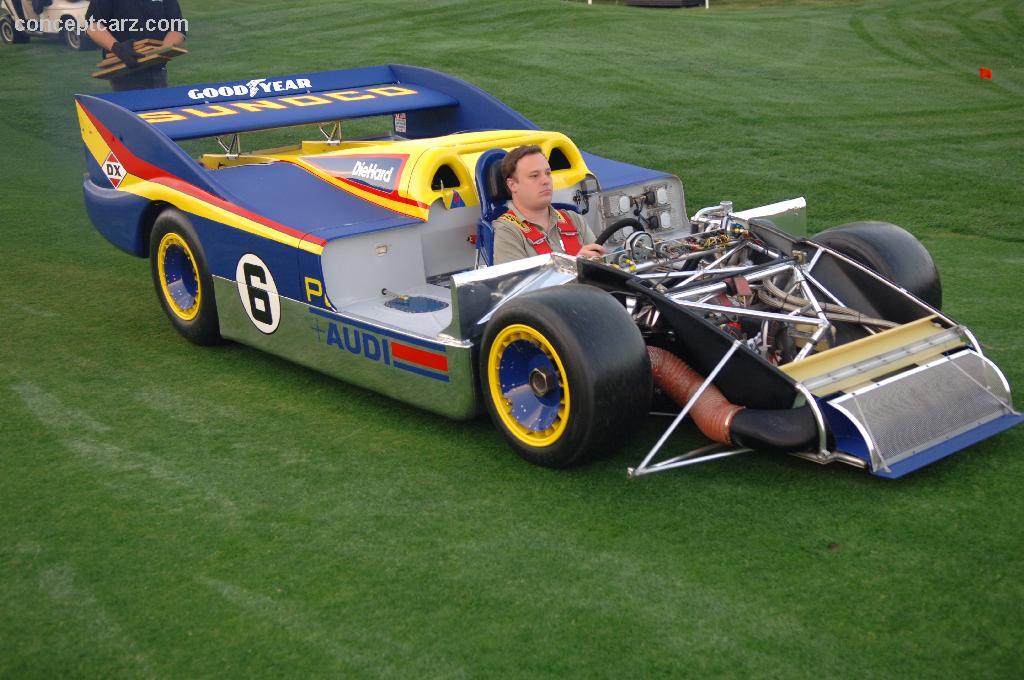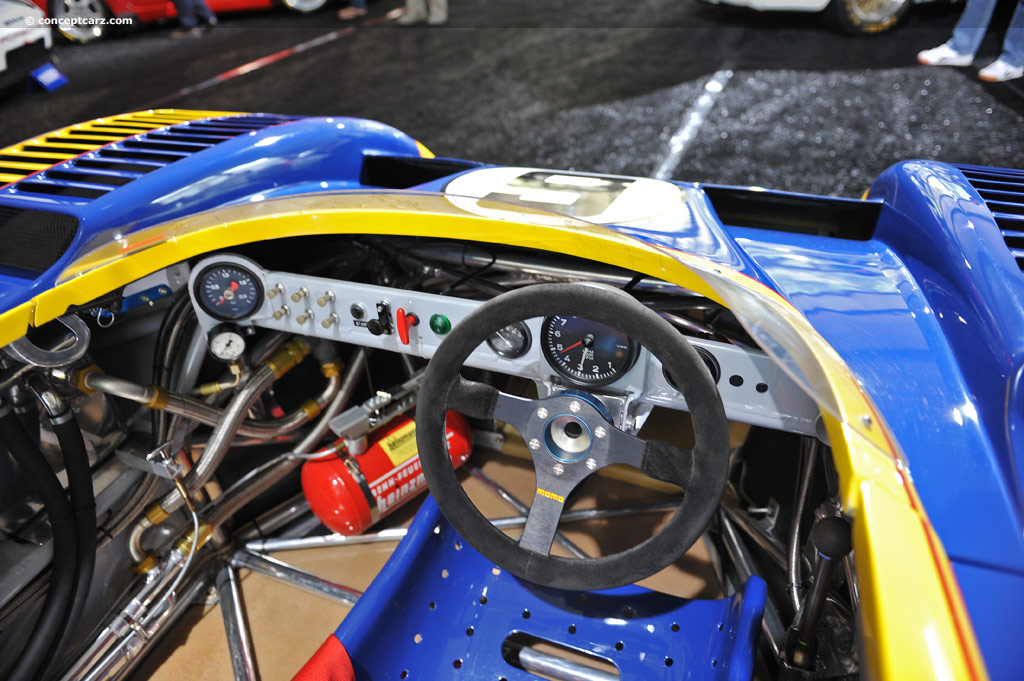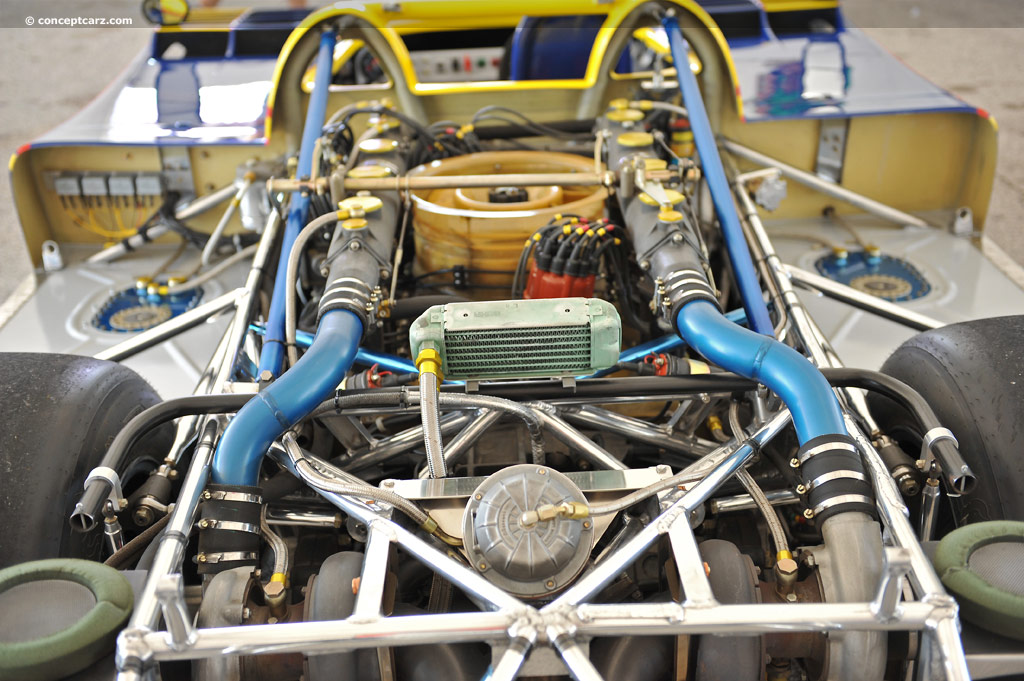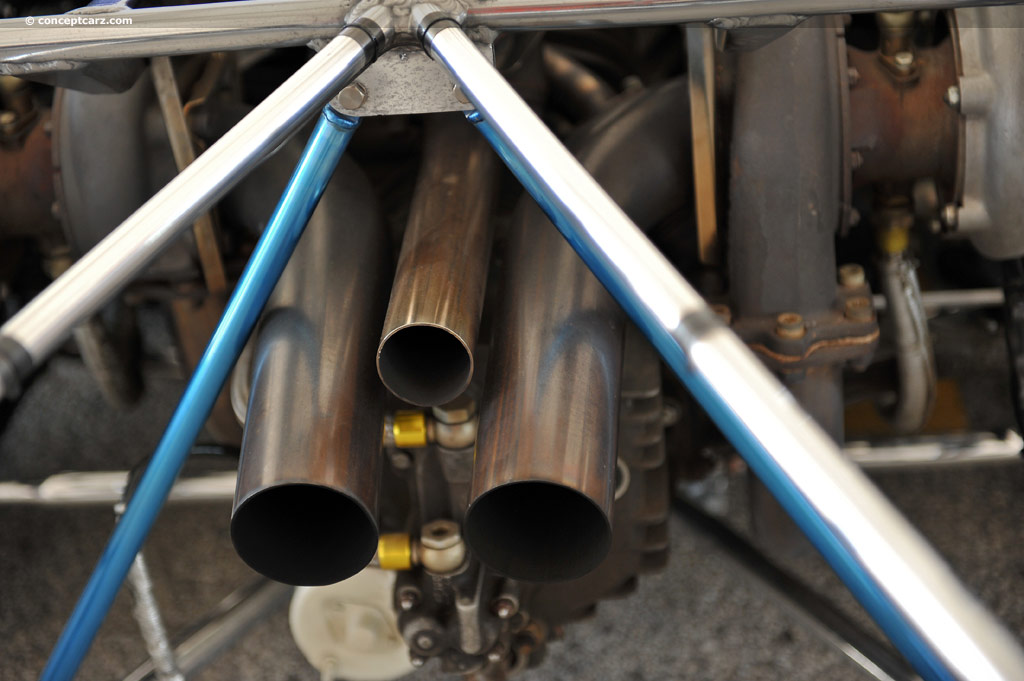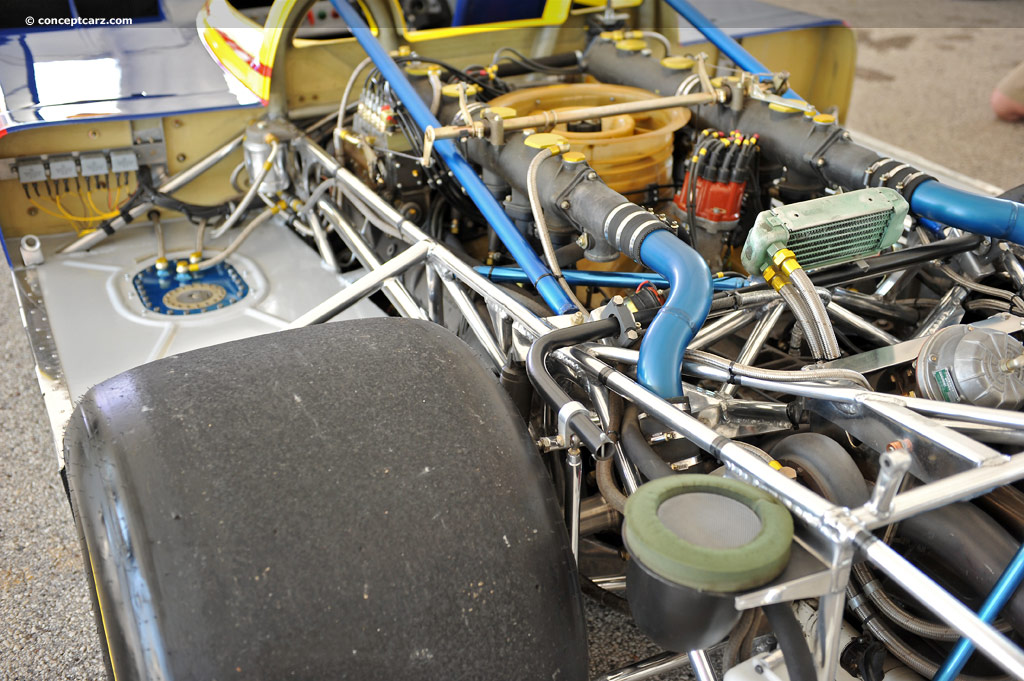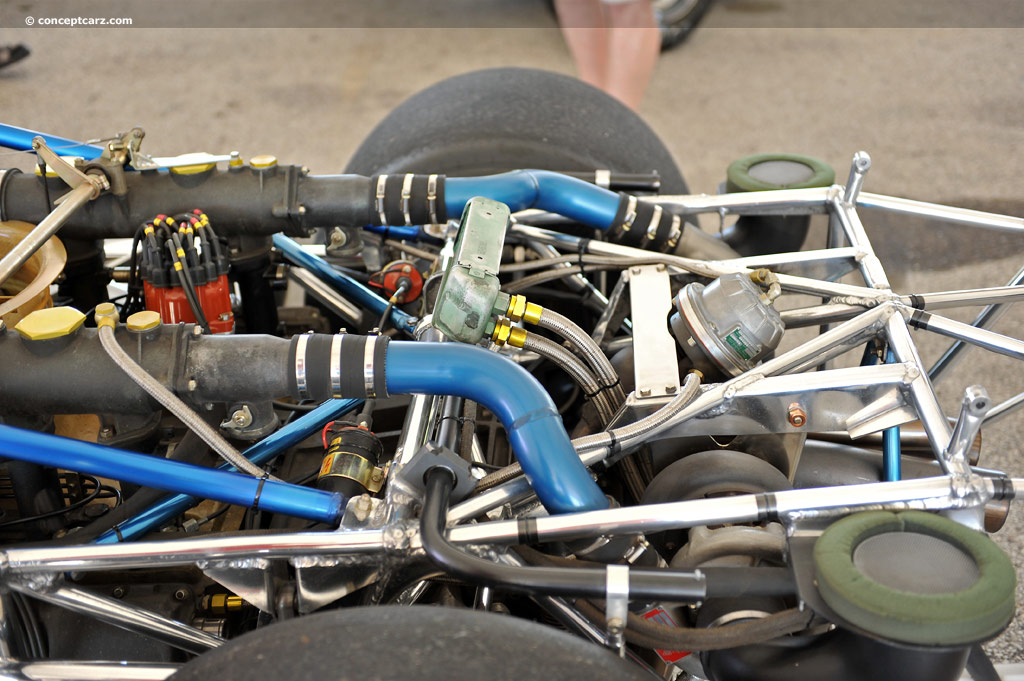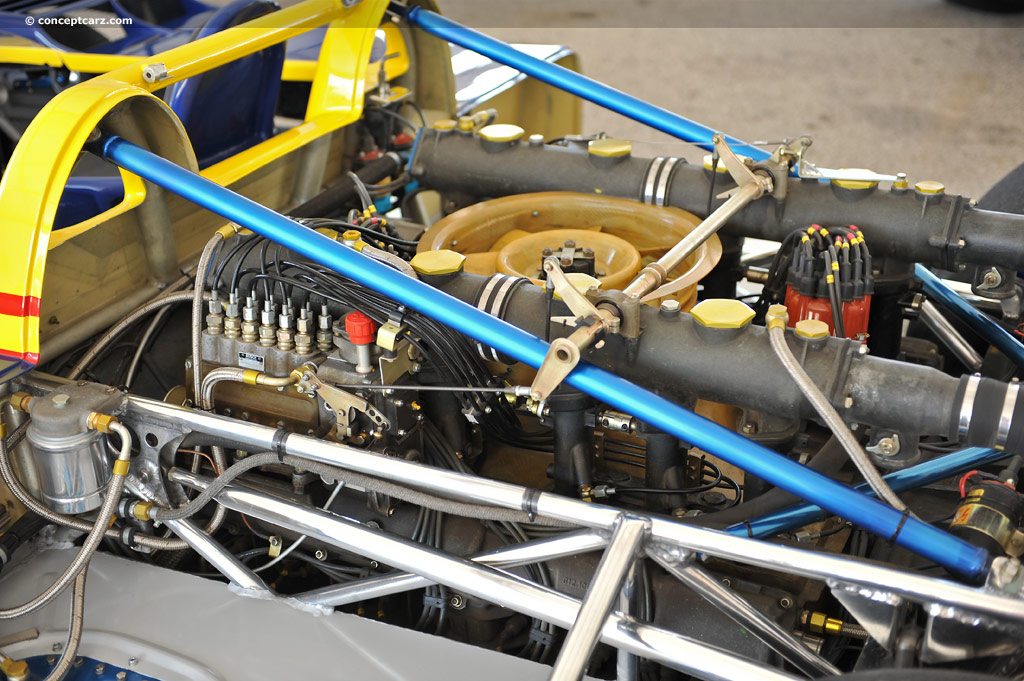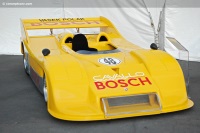Image credit: © conceptcarz.com (Reproduction Or reuse prohibited). Porsche.
1973 Porsche 917-30
The 917-30 was the ultimate evolution of the 917, with a 5.4 liter 1200 HP 12-cylinder engine. Prepared by Penske Racing and driven by Mark Donohue it dominated the 1973 Can-Am series. This car is serial number 004 which was to be Mark's brand new car for the 1974 season. After the 917/30 was legislated out of the series, Porsche sold the car to Australian Porsche importer Alan Hamilton, and then later took 917/30-004 back as partial payment on a loan they had given him. At the 1998 Monterey Historics, 917/30-004 was driven to victory in the Can-Am group by Porsche's own Olaf Lang. It was also driven by Roger Penske at the 2001 Rennsport Reunion. It was a concours class winner at the second Porsche Rennsport Reunion in 2004.Chassis 917/30.004 - One of two cars Porsche AG completed after the competitive era, this one for Alan Hamilton, the Australian Porsche distributor.
In modern times, the Porsche 917/30 is still considered to be one of Porsche's greatest racing cars. It was designed for only one driver, Mark Donohue. Helmut Flegl gave it a long wheelbase and spyder configuration, including the addition of the rear body from the 240 mph 917LH long tail endurance coupes that ran at Le Mans. Donohue suffered problems with the first two races of 1973, but after that he remained unchallenged, winning the remainder of the races to claim Porsche's second straight Can Am crown. After being so dominant, the SCCA reduced its fuel capacity to the point that the car was unable to be competitive.
The car had a dry weight of 1680 lbs and could produce up to 1500 horsepower. It was easy to see the advantage of this vehicle.
After the 1974 season, the car was purchased from Porsche by the Australian Porsche importer Alan Hamelton. It was later re-purchased by Porsche, painted in Sunoco colors, and displayed in their museum until David Morse purchased the car in 1994. It was given a full restoration and then purchased by Matthew Drendel.
Currently, the car remains active in vintage racing and was even driven by Roger Penske at the 2001 Porsche Rennsport Reunion. It currently resides in the Drendel collection, along with many other Porsche racing cars including the 2.1 Martini 'baby' Turbo, 934, 935, 959 Sport, 962, 968 Turbo RS, 911 GT1, and 911 GT2 Evolution.
Perfection in a race car is something that is greatly sought by each and every designer. But rarely does one find the 'perfect race car'. However, in 1973 Roger Penske provided Mark Donohue exactly that. As far as Donohue was concerned, the Porsche 917/30 Can-Am Spyder was the perfect blend of power and handling, performance and agility. But it would also be considered the car that killed the Can-Am series all together.
The lineage of the Porsche 917 stretches all the way back to prior 1970. The design would go on to great success and fame in the 24 Hours of Le Mans and other sportscar endurance races. However, after 1971, the coupe 917 would no longer be allowed to race in the World Championship. It was obvious there was still a lot of life in the Porsche's legs but it needed to find a place it could really run. And while the car that had been a part of the Group 7 category for a number of years would be able to take part in the European Interserie it would be in North America where it really could run the most wild and free.
Inaugurated in 1966, the Canadian American Challenge Cup would start out as a series for the Group 7 sportscars but would feature unrestrictive engine capacity and fewer technical regulations. Just about anything would go in Can-Am racing and it would help to give birth to greater aerodynamics testing and engine options.
Although the European Interserie would also run similar Group 7 cars the Can-Am cars were considered the best and most powerful in the world with engine power delivering upwards of 900 to 1000 hp. Proving that it wasn't always about the racing, the sound of the engines and the outright speed and performance of the cars would make the series highly popular with spectators and drivers alike.
Around the beginning of the '70s, the McLarens were the dominant figures in the series. Porsche had a number of entries in the series at the time, mostly small teams with a limited budget. As a result, when compared to the power of the McLarens, the Porsche 908s and adapted 917s would struggle to keep pace.
Porsche, looking for a place to roam free, would look to the Can-Am series. The factory would take its 917 but would build a specific version for the series called the 917/10. The Can-Am series was unlimited and in building the new car Porsche would look to metals and alloys that were very limiting because of their price but were certain to produce the kind of results the factory was looking for.
While boasting of a 5-liter, flat-12 cylinder engine, the 917/10 would still be underpowered when compared to the rest of the competition, including McLaren and Lola. Porsche needed more power but was in something of a conundrum as exactly how to find it. There were options, including a 16-cylinder engine, but they all seemed to be heading in the opposite direction from where Porsche wanted it to go. A bigger engine or the addition of a supercharger meant more weight and a likely unequal distribution in the weight of the car. Porsche knew which way it wanted to go but could it make it work.
Twin turbocharging was the direction Porsche wanted to go. The question was whether or not it would work or not. Turbocharging was still rather new at the time. But what was known was that there were some performance limitations on the technology.
To be effective, engine speeds needed to remain quite high for the power to be available. This meant the slow corners would bring about a kick in the pants like none other. This brought about the other problem. Even without turbocharging the engine in the 917/10 was producing a tremendous amount of power, it just wasn't enough. However, with the power the engine already had in spades, when the turbo kicked in during acceleration, the forces acting on the car would require a driver of incredible skill just to keep from killing himself, let alone turn the incredible performance into a victory at the circuit. And the problem with the lag didn't just happen once every lap. Therefore, the driver would not have to have the talent to control the car, but also, the endurance to do it for 200 miles.
Roger Penske's team would have a couple of those special drivers. Mark Donohue and George Follmer were both willing to take to the wheel of the 1,000 hp car. And while Donohue would be considered the more talented of the two drivers, an early season injury would see Follmer take on the driving duties.
The power and the aerodynamics of the car would make it almost matter not at all who the driver of the car actually was. George Follmer would use the power and handling of the 917/10 to great effect and would finally break Bruce McLaren Motor Racing's five year hold on the Can-Am Series championship.
But Porsche wasn't done. Roger Penske's team had taken six victories out of nine races. It wasn't like the racing had been tight. But Porsche's, Donohue's and Penske's desire to dominate would dictate there was more the factory needed to do. And when they all finished, the collaborators would produce what Donohue considered to be the 'perfect race car'.
It would all start with increased engine power. Easily pushing 1,100 hp in race trim, the new car, called the 917/30, would have power in abundance. It would be greatly whispered the actual horsepower rating of the engine pushed in excess of 1,500 hp in qualifying trim.
In order to take advantage of the incredible horsepower, the plexi-glass body would be redesigned with even greater aerodynamic efficiency. The car would be shorter providing less drag. And in order to keep the power headed in the right direction, the wheelbase of the car would be lengthened and the width increased.
The result would be truly incredible when in the hands of Donohue. While the first two races would be won by competitors, the final six rounds of the championship would be won by Donohue in dominant fashion. And by the end of the season, Donohue would take the championship having more than double the points of his closest rival, which happened to be George Follmer driving for Rinzler Motorracing Royal Crown.
An absolutely remarkable achievement, the Porsche 917/30 would not struggle to break 200 mph and would actually be capable of reaching speeds in excess of 240 mph. Having an acceleration rate that allowed the car to go from zero to 60 mph in under 2 seconds and zero to 200 in a little more than 10 seconds, there was little left for Can-Am to try and achieve because it would begin to travel into the realm too dangerous and ultimately unachievable with a human pilot. So in many ways, Porsche 917/30 would rightfully deserve the reputation of being the car that killed Can-Am.
Such performance is nearly unheard of today unless one happened to have a few million lying around. For at the 2012 Gooding and Company auction held at Amelia Island in Florida, one such Porsche 917/30 would come up for auction.
Chassis 917/30-004 never actually raced. The car was being produced for the 1974 season. However, with Penske's and Porsche's withdrawal from the series the car had been built with no place to go and race. Finished in an all-white livery, the car would be sold to Australian Porsche importer Alan Hamilton. While with Hamilton the car would mainly sit as a display but would show up a various events throughout the country.
In the early 1990s, the car would head back to Europe, specifically Porsche. During its time back with Porsche the car would be finished in the same 1973 Sunoco livery that adorned chassis 917/30-002. The car would then make an appearance at the Nurburgring in 1992 taking part in the Old Timer Grand Prix. At that time, the car would be sold and would be shipped to the United States but not before the car was given a rebuilt engine using the last remaining 5.4-liter block. This rebuilt engine, in a dyno test, would prove capable of still producing an incredible 1,200 hp. Featuring the rebuilt engine, the Bosch mechanical fuel injection, the twin KKK Turbochargers, the 4-speed manual gearbox and the fully independent double wishbone suspension, this chassis would go on to prove what it never got the chance to do in its former life. An obvious performer that never found its way to the stage, chassis 917/30-004 would go on to power its way to the 1998 Monterey Historics victory.
In 2001, the car would be purchased by Matt Drendel and would remain with him until his death in 2010. Driven by Roger Penske himself in the Rennsport Reunion, this Porsche 917/30 Can-Am Spyder truly represents the pinnacle of the Can-Am series. And even without a racing heritage, this particular chassis is still something truly special. For this, the car would be estimated to earn between $3,250,000 and $4,000,000 at this year's auction. However, this important piece of Can-Am and car performance history would do much better. When it was all said and done, the car would bring in $4,400,000.
Sources:
'Lot No. 57: 1973 Porsche 917/30 Can-Am Spyder', (http://www.goodingco.com/car/1973-porsche-91730-can-am-spyder). Gooding and Company. http://www.goodingco.com/car/1973-porsche-91730-can-am-spyder. Retrieved 13 March 2012.
'Porsche 917/30', (http://www.ultimatecarpage.com/car/422/Porsche-917-30.html). Ultimatecarpage.com: Powered by Knowledge, Driven by Passion. http://www.ultimatecarpage.com/car/422/Porsche-917-30.html. Retrieved 13 March 2012.
'Porsche 917/10', (http://www.ultimatecarpage.com/car/420/Porsche-917-10K.html). Ultimatecarpage.com: Powered by Knowledge, Driven by Passion. http://www.ultimatecarpage.com/car/420/Porsche-917-10K.html. Retrieved 13 March 2012.
Wikipedia contributors, 'Porsche 917', Wikipedia, The Free Encyclopedia, 4 March 2012, 03:17 UTC, http://en.wikipedia.org/w/index.php?title=Porsche_917&oldid=480085125 accessed 13 March 2012
'Porsche 917/30, 'The Perfect Race Car,' to be Auctioned at Amelia Island', (http://blog.hemmings.com/index.php/2012/02/17/porsche-91730-the-perfect-race-car-to-be-auctioned-at-amelia-island/). Hemmings Blog: The World's Largest Collector-Car Marketplace. http://blog.hemmings.com/index.php/2012/02/17/porsche-91730-the-perfect-race-car-to-be-auctioned-at-amelia-island/. Retrieved 13 March 2012.
Wikipedia contributors, 'Can-Am', Wikipedia, The Free Encyclopedia, 22 February 2012, 16:59 UTC, http://en.wikipedia.org/w/index.php?title=Can-Am&oldid=478274166 accessed 13 March 2012By Jeremy McMullen
The lineage of the Porsche 917 stretches all the way back to prior 1970. The design would go on to great success and fame in the 24 Hours of Le Mans and other sportscar endurance races. However, after 1971, the coupe 917 would no longer be allowed to race in the World Championship. It was obvious there was still a lot of life in the Porsche's legs but it needed to find a place it could really run. And while the car that had been a part of the Group 7 category for a number of years would be able to take part in the European Interserie it would be in North America where it really could run the most wild and free.
Inaugurated in 1966, the Canadian American Challenge Cup would start out as a series for the Group 7 sportscars but would feature unrestrictive engine capacity and fewer technical regulations. Just about anything would go in Can-Am racing and it would help to give birth to greater aerodynamics testing and engine options.
Although the European Interserie would also run similar Group 7 cars the Can-Am cars were considered the best and most powerful in the world with engine power delivering upwards of 900 to 1000 hp. Proving that it wasn't always about the racing, the sound of the engines and the outright speed and performance of the cars would make the series highly popular with spectators and drivers alike.
Around the beginning of the '70s, the McLarens were the dominant figures in the series. Porsche had a number of entries in the series at the time, mostly small teams with a limited budget. As a result, when compared to the power of the McLarens, the Porsche 908s and adapted 917s would struggle to keep pace.
Porsche, looking for a place to roam free, would look to the Can-Am series. The factory would take its 917 but would build a specific version for the series called the 917/10. The Can-Am series was unlimited and in building the new car Porsche would look to metals and alloys that were very limiting because of their price but were certain to produce the kind of results the factory was looking for.
While boasting of a 5-liter, flat-12 cylinder engine, the 917/10 would still be underpowered when compared to the rest of the competition, including McLaren and Lola. Porsche needed more power but was in something of a conundrum as exactly how to find it. There were options, including a 16-cylinder engine, but they all seemed to be heading in the opposite direction from where Porsche wanted it to go. A bigger engine or the addition of a supercharger meant more weight and a likely unequal distribution in the weight of the car. Porsche knew which way it wanted to go but could it make it work.
Twin turbocharging was the direction Porsche wanted to go. The question was whether or not it would work or not. Turbocharging was still rather new at the time. But what was known was that there were some performance limitations on the technology.
To be effective, engine speeds needed to remain quite high for the power to be available. This meant the slow corners would bring about a kick in the pants like none other. This brought about the other problem. Even without turbocharging the engine in the 917/10 was producing a tremendous amount of power, it just wasn't enough. However, with the power the engine already had in spades, when the turbo kicked in during acceleration, the forces acting on the car would require a driver of incredible skill just to keep from killing himself, let alone turn the incredible performance into a victory at the circuit. And the problem with the lag didn't just happen once every lap. Therefore, the driver would not have to have the talent to control the car, but also, the endurance to do it for 200 miles.
Roger Penske's team would have a couple of those special drivers. Mark Donohue and George Follmer were both willing to take to the wheel of the 1,000 hp car. And while Donohue would be considered the more talented of the two drivers, an early season injury would see Follmer take on the driving duties.
The power and the aerodynamics of the car would make it almost matter not at all who the driver of the car actually was. George Follmer would use the power and handling of the 917/10 to great effect and would finally break Bruce McLaren Motor Racing's five year hold on the Can-Am Series championship.
But Porsche wasn't done. Roger Penske's team had taken six victories out of nine races. It wasn't like the racing had been tight. But Porsche's, Donohue's and Penske's desire to dominate would dictate there was more the factory needed to do. And when they all finished, the collaborators would produce what Donohue considered to be the 'perfect race car'.
It would all start with increased engine power. Easily pushing 1,100 hp in race trim, the new car, called the 917/30, would have power in abundance. It would be greatly whispered the actual horsepower rating of the engine pushed in excess of 1,500 hp in qualifying trim.
In order to take advantage of the incredible horsepower, the plexi-glass body would be redesigned with even greater aerodynamic efficiency. The car would be shorter providing less drag. And in order to keep the power headed in the right direction, the wheelbase of the car would be lengthened and the width increased.
The result would be truly incredible when in the hands of Donohue. While the first two races would be won by competitors, the final six rounds of the championship would be won by Donohue in dominant fashion. And by the end of the season, Donohue would take the championship having more than double the points of his closest rival, which happened to be George Follmer driving for Rinzler Motorracing Royal Crown.
An absolutely remarkable achievement, the Porsche 917/30 would not struggle to break 200 mph and would actually be capable of reaching speeds in excess of 240 mph. Having an acceleration rate that allowed the car to go from zero to 60 mph in under 2 seconds and zero to 200 in a little more than 10 seconds, there was little left for Can-Am to try and achieve because it would begin to travel into the realm too dangerous and ultimately unachievable with a human pilot. So in many ways, Porsche 917/30 would rightfully deserve the reputation of being the car that killed Can-Am.
Such performance is nearly unheard of today unless one happened to have a few million lying around. For at the 2012 Gooding and Company auction held at Amelia Island in Florida, one such Porsche 917/30 would come up for auction.
Chassis 917/30-004 never actually raced. The car was being produced for the 1974 season. However, with Penske's and Porsche's withdrawal from the series the car had been built with no place to go and race. Finished in an all-white livery, the car would be sold to Australian Porsche importer Alan Hamilton. While with Hamilton the car would mainly sit as a display but would show up a various events throughout the country.
In the early 1990s, the car would head back to Europe, specifically Porsche. During its time back with Porsche the car would be finished in the same 1973 Sunoco livery that adorned chassis 917/30-002. The car would then make an appearance at the Nurburgring in 1992 taking part in the Old Timer Grand Prix. At that time, the car would be sold and would be shipped to the United States but not before the car was given a rebuilt engine using the last remaining 5.4-liter block. This rebuilt engine, in a dyno test, would prove capable of still producing an incredible 1,200 hp. Featuring the rebuilt engine, the Bosch mechanical fuel injection, the twin KKK Turbochargers, the 4-speed manual gearbox and the fully independent double wishbone suspension, this chassis would go on to prove what it never got the chance to do in its former life. An obvious performer that never found its way to the stage, chassis 917/30-004 would go on to power its way to the 1998 Monterey Historics victory.
In 2001, the car would be purchased by Matt Drendel and would remain with him until his death in 2010. Driven by Roger Penske himself in the Rennsport Reunion, this Porsche 917/30 Can-Am Spyder truly represents the pinnacle of the Can-Am series. And even without a racing heritage, this particular chassis is still something truly special. For this, the car would be estimated to earn between $3,250,000 and $4,000,000 at this year's auction. However, this important piece of Can-Am and car performance history would do much better. When it was all said and done, the car would bring in $4,400,000.
Sources:
'Lot No. 57: 1973 Porsche 917/30 Can-Am Spyder', (http://www.goodingco.com/car/1973-porsche-91730-can-am-spyder). Gooding and Company. http://www.goodingco.com/car/1973-porsche-91730-can-am-spyder. Retrieved 13 March 2012.
'Porsche 917/30', (http://www.ultimatecarpage.com/car/422/Porsche-917-30.html). Ultimatecarpage.com: Powered by Knowledge, Driven by Passion. http://www.ultimatecarpage.com/car/422/Porsche-917-30.html. Retrieved 13 March 2012.
'Porsche 917/10', (http://www.ultimatecarpage.com/car/420/Porsche-917-10K.html). Ultimatecarpage.com: Powered by Knowledge, Driven by Passion. http://www.ultimatecarpage.com/car/420/Porsche-917-10K.html. Retrieved 13 March 2012.
Wikipedia contributors, 'Porsche 917', Wikipedia, The Free Encyclopedia, 4 March 2012, 03:17 UTC, http://en.wikipedia.org/w/index.php?title=Porsche_917&oldid=480085125 accessed 13 March 2012
'Porsche 917/30, 'The Perfect Race Car,' to be Auctioned at Amelia Island', (http://blog.hemmings.com/index.php/2012/02/17/porsche-91730-the-perfect-race-car-to-be-auctioned-at-amelia-island/). Hemmings Blog: The World's Largest Collector-Car Marketplace. http://blog.hemmings.com/index.php/2012/02/17/porsche-91730-the-perfect-race-car-to-be-auctioned-at-amelia-island/. Retrieved 13 March 2012.
Wikipedia contributors, 'Can-Am', Wikipedia, The Free Encyclopedia, 22 February 2012, 16:59 UTC, http://en.wikipedia.org/w/index.php?title=Can-Am&oldid=478274166 accessed 13 March 2012By Jeremy McMullen
2016 Gooding & Company : The Amelia Island Auction
Pre-Auction Estimates :
USD $5,000,000-USD $7,000,000
Sale Price :
USD $3,000,000
2012 Gooding & Company, Amelia Island, Fl
Pre-Auction Estimates :
USD $3,250,000-USD $4,000,000
Sale Price :
USD $4,400,000
1973 Porsche 917/30 Auction Sales
Recent Sales of the Porsche 917/30
(Data based on Model Year 1973 sales)
| 1973 Porsche 917/30 Can-Am Spyder Chassis#: 917/30-004 Sold for USD$3,000,000 2016 Gooding & Company : The Amelia Island Auction |   |
| 1973 Porsche 917/30 Can-Am Spyder Chassis#: 917/30-005 Sold for USD$2,703,598 2014 RM Auctions - Paris |   |
| 1973 Porsche 917-30 Can-Am Spyder Chassis#: 917-30-004 Sold for USD$4,400,000 2012 Gooding & Company, Amelia Island, Fl |   |
Porsche 917/30s That Failed To Sell At Auction
1973 Porsche 917/30's that have appeared at auction but did not sell.
| Vehicle | Chassis | Event | High Bid | Est. Low | Est. High |
|---|
Vehicles With Comparable Market Values
Similar sales to the $3,367,866 range.
| 2009 Mercedes-Benz SLR McLaren Stirling Moss Chassis#:WDD1999761M900066 Sold for $3,211,250 2024 RM Sothebys : Dubai | |
| 2016 Koenigsegg Agera RSR Chassis#:YT9ML1A21FA007123 Sold for $3,380,000 2024 RM Sothebys : Dubai | |
| 1973 Ferrari 365 GTB/4 Daytona Spider Chassis#:16857 Sold for $3,305,000 2024 Broad Arrow Auctions : Amelia |   |
| 1990 Ferrari F40 Chassis#:ZFFGJ34B000084116 Sold for $3,360,000 2024 RM Sothebys : ModaMiami | |
| 2015 PORSCHE 918 SPYDER WEISSACH Chassis#:WP0CA2A12FS800325 Sold for $3,525,000 2024 Gooding : Amelia Island Concours | |
| 1966 Ferrari 275 GTB/6C Alloy by Scaglietti Chassis#:08259 Sold for $3,485,930 2024 RM Sothebys : Paris | |
| 2007 Maserati MC12 Versione Corsa Chassis#:ZAMDF44B000029631 Sold for $3,302,745 2024 RM Sothebys : Paris | |
| 1956 MERCEDES-BENZ 300SL GULLWING COUPE Chassis#:1980406500225 Sold for $3,410,000 2024 Barrett-Jackson : Scottsdale AZ | |
| 1992 Ferrari F40 Chassis#:zffmn34a3n0092396 Sold for $3,410,000 2024 Mecum : Kissimmee |  |
| 1973 Ferrari 365 GTS/4 Daytona Spider by Scaglietti Chassis#:16689 Sold for $3,391,680 2023 RM Sothebys : Munich | |
| 1966 FERRARI 275 GTB Chassis#:08545 Sold for $3,415,000 2023 Gooding & Company : Pebble Beach |   |
| 1967 FERRARI 275 GTB/4 Chassis#:09909 Sold for $3,277,500 2023 Gooding & Company : Pebble Beach |  |
| 1965 Ferrari 275 GTB/6C Alloy by Scaglietti Chassis#:07809 Sold for $3,305,000 2023 RM Sothebys : Monterey |   |
| 1990 Ferrari F40 Chassis#:ZFFGJ34B000084116 Sold for $3,305,000 2023 RM Sothebys : Monterey | |
| 1966 Ferrari 275 GTB/6C Alloy Berlinetta Chassis#:08157 Sold for $3,410,000 2023 Mecum : Monterey |   |
| 1933 Packard Twelve Individual Custom Convertible Victoria by Dietrich Chassis#:901360 Sold for $3,305,000 2023 RM Sothebys : Monterey |   |
| 1967 FERRARI 275 GTB/4 Chassis#:10803 Sold for $3,525,000 2023 Gooding & Company : Amelia Island Auction |   |
| 1953 FERRARI 250 MM SPIDER SERIES II Chassis#:0274 MM Sold for $3,525,000 2023 Gooding & Company : Amelia Island Auction |  |
| 1967 Ferrari 275 GTB/4 By Scaglietti Chassis#:09505 Sold for $3,383,215 2023 RM Sothebys : Paris | |
| 1967 Ferrari 275 GTB/4 by Scaglietti Chassis#:10325 Sold for $3,360,000 2023 RM Sothebys : Arizona |  |
1973 Porsche 917/30
• Additional valuation insight and sales data• History
• Specifications
• Image gallery
• Other Porsche 917/30 model years
